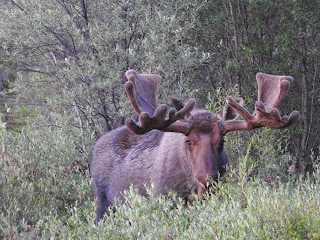Summary of Feb 23, 2015 class by Heide Andersen
This class on "fire and wildlife" was co-led by
Bill Gaines (wildlife ecologist and director of Washington Conservation Science Institute) and
Ken Bevis (WA Dept of Natural Resources Stewardship Wildlife Biologist).
Bill was an appropriate
 |
| The Pipestone (here, before 2014's fire) is fire-adapted land. |
|
presenter for this portion of the course, having worked on both natural resource management and research focused on fire and wildlife. Within the Methow Valley, there are fire regimes and wildlife adaptations to fire that result in a “fire disturbance ecology.” There are some species, such as the whitebark pine that occur in areas known for experiencing high severity (stand replacement) and less frequent fires. From there, the subalpine fire and then the ponderosa pine stands fall under the mixed severity fire regime and the grasslands are in the low severity fire regime, where fires have historically been more frequent, but much patchier.
The over 400 species of wildlife found in our part of the country each have their own adaptations and behavior related to fire. In general, wildlife have the ability to live in a fire-prone area and escape from direct mortality during events. The big exception would be species that are not mobile and live above-ground (such as the Chelan mountain snail). Species with smaller or more fragmented populations tend to be more affected, whereas species that are associated with snags and understory habitats tend to immediately benefit from fires.
High severity fire areas and wildlife
The Canada lynx is associated with areas that have historically experienced high severity fires. Although they might avoid the big open clearings from a burned stand, they will use the edges and the mosaic habitat created near the edge for hunting. They will use large downed trees for denning habitat and the young lodgepole pines that emerge are great habitat for their primary prey, the snowshoe hare. Snag-dependent species, such as the three-toed and black-backed woodpeckers, increase in numbers when there is a maximum number of snags post-fire. They come in after the insects and are primary cavity nesters. As the forest begins to regenerate, and the density of snags goes down, other birds appear that favor the new shrub layer and the Lewis’s woodpecker, who favor larger openings and fewer snags, will flourish.
 |
| A Northern goshawk in a Douglas fir in the Methow |
Mixed severity fire areas and wildlife
The northern goshawk and northern spotted owl are two species known to seek out areas with a mixed severity fire regime. Both of these species like closed canopy forests with multiple structural layers, mistletoe (which is very flammable), and that are generally more susceptible to fire and yet will nest in areas with a low fire severity regime.
Low severity fire areas and wildlife
Species that prefer lots of space where trees can get quite large with lots of openings and gaps will be found in these areas. Sharp-tailed grouse is one of these species. Many ungulates prefer these areas as well. Although they may experience a decrease in food resources following a fire and a potentially severe winter from a forage perspective, generally there will be an increase in food resources in the long-term following fires in these areas. The Chelan mountain snail favors these areas and will burrow in the dry soil to reach moisture, so they will tend to be deeper during fire events, depending on the timing. All of these species benefit from prescribed fires that can lessen the impact from larger and more severe wildfires.
Restoration Strategy
We have altered fire regimes and are experiencing the impacts of climate change. We no longer have the old trees that used to reach over 64” in diameter that were the most resistant to fire. The combination of fire seclusion and harvesting of the older specimens has left a habitat that is less resilient. Bugs exacerbate the fuel loads and our snowpack has been changing over time. It is predicted that we will have 2 to 4 times the amount of fire by the 2040’s that we have now.
When we look at forest restoration treatments and how they relate to wildlife, there are several things to consider. It is important to look at the reference condition, i.e. whether there were landscape-level fires in an area versus smaller scale events, what the focal wildlife species and their habitat requirements are, and integrate restoration priorities to address habitat resiliency. Stand level considerations should include elements such as keeping the old and large trees, incorporating snags and having spatial variability.
 |
| Lewis's Woodpeckers and a snag with lots of cavity holes |
Ken Bevis, “Managed Wildlife Habitat and Fire”
In dry forest management, we should have a goal to retain
the large trees. We should also recognize that dead trees give life to other species. (
See a great article by Ken on this topic here) Important elements in forest management follow the acronym “SLOPPS” which stands for snags, logs, openings, piles, patches, and shrubs. Ken showed some schematics of what these elements look like and how they might be incorporated into a managed stand or a restoration effort. He demonstrated how habitat piles can be created on individual properties that are very valuable to wildlife.
In looking at whether salvage logging should occur post-fire, Ken said people should be very careful. With the likelihood of soil damage from such practices, it needs to be done thoughtfully, with caution and with an eye toward what the desired future condition of the site will be.
Our landscape is resilient, but we do need to get back to a more resilient dry forest type historically characteristic of our Methow Valley.
All the classes are being filmed too. Videos are on our website here: http://methowconservancy.org/conservation_course_2015_videos.html. Scroll down for the 5th class.




















































